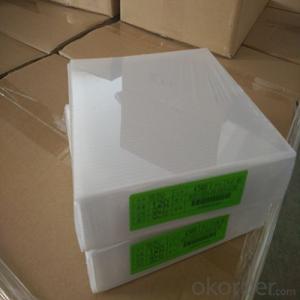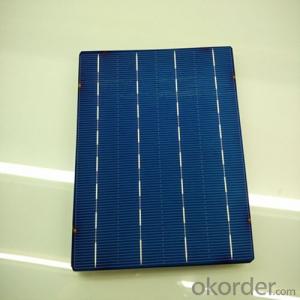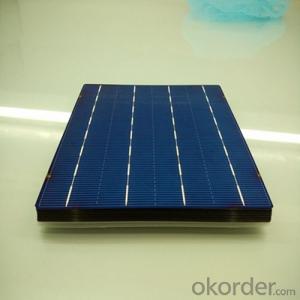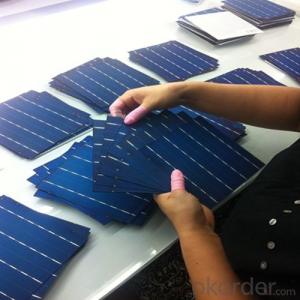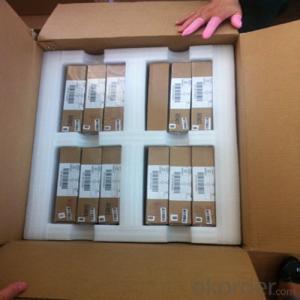Mono 156X156MM2 Solar Cells Good Price
- Loading Port:
- Shanghai
- Payment Terms:
- TT OR LC
- Min Order Qty:
- 8000 watt
- Supply Capability:
- 650000 watt/month
OKorder Service Pledge
OKorder Financial Service
You Might Also Like
Benefits of Solar Power:
Now is a great time to go solar and harvest the power of the sun. Here is our top ten list of the benefits to installing solar power:
When installed, solar energy is free – no resources are consumed
Help to lessen our dependence on heavily polluting coal power stations
Fossil fuels can't last forever, future generations will appreciate the effort
Characteristic of Mono 156X156MM2 Solar Cells
You are gaining energy independence - add battery backup power for even greater energy security
The cost of electricity is only going to rise – insure against that rising cost
Quality solar power and water adds value and appeal to your home
Specifications of Mono 156X156MM2 Solar Cells
Solar PV systems are easily upgraded in future - aim to make your house a net energy producer!
Solar panels offer a long lifetime of low maintenance service, maybe 30-40 years
Your friends will think you're great!
You'll feel great for doing your bit for the environment!
Mechanical data and design
Format | 156mm x 156mm±0.5mm |
Thickness | 210μm±40μm |
Front(-) | 1.5mm bus bar (silver),blue anti-reflection coating (silicon nitride) |
Back (+) | 2.5mm wide soldering pads (sliver) back surface field (aluminium) |
Temperature Coefficient of Cells
Voc. Temp.coef.%/K | -0.35% |
Isc. Temp.coef .%/K | +0.024%/K |
Pm.Temp.coef. %/K | -0.47%/K |
Electrical Characteristic
Effiency(%) | Pmpp(W) | Umpp(V) | Impp(A) | Uoc(V) | Isc(A) | FF(%) |
18.35 | 4.384 | 0.526 | 8.333 | 0.63 | 8.877 | 78.39% |
18.20 | 4.349 | 0.526 | 8.263 | 0.63 | 8.789 | 78.54% |
18.05 | 4.313 | 0.525 | 8.216 | 0.63 | 8.741 | 78.32% |
17.90 | 4.277 | 0.524 | 8.161 | 0.625 | 8.713 | 78.04% |
17.75 | 4.241 | 0.523 | 8.116 | 0.625 | 8.678 | 77.70% |
17.60 | 4.206 | 0.521 | 8.073 | 0.625 | 8.657 | 77.36% |
17.45 | 4.170 | 0.519 | 8.039 | 0.625 | 8.633 | 76.92% |
17.30 | 4.134 | 0.517 | 8.004 | 0.625 | 8.622 | 76.59% |
17.15 | 4.096 | 0.516 | 7.938 | 0.625 | 8.537 | 76.80% |
17.00 | 4.062 | 0.512 | 7.933 | 0.625 | 8.531 | 76.18% |
16.75 | 4.002 | 0.511 | 7.828 | 0.625 | 8.499 | 75.34% |
16.50 | 3.940 | 0.510 | 7.731 | 0.625 | 8.484 | 74.36% |
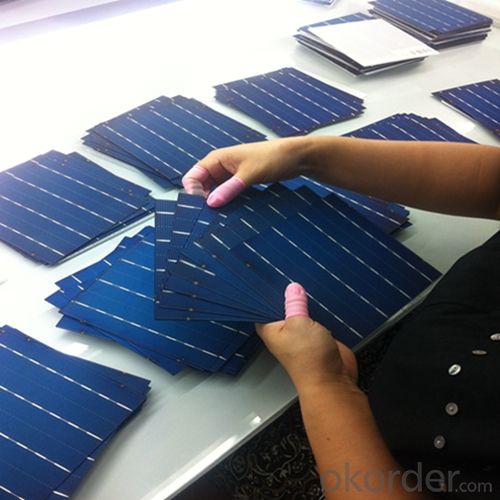

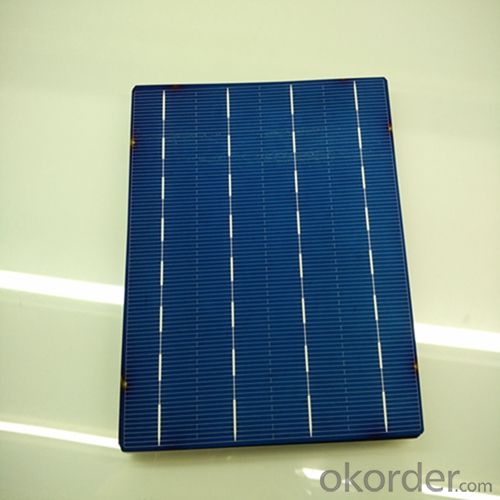
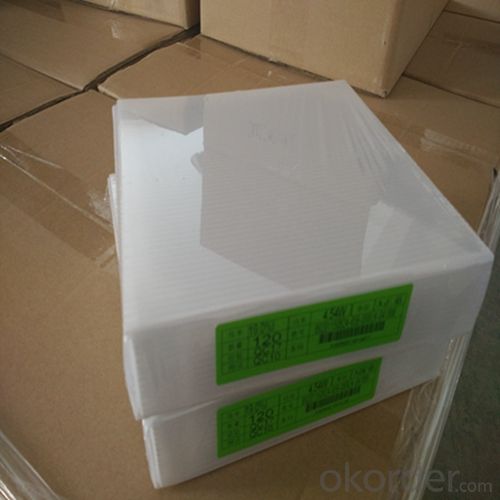

FAQ
Q: What price for each watt?
A: It depends on the quantity, delivery date and payment terms, generally Large Quantity and Low Price
Q: What is your size for each module? Can you tell me the Parameter of your module?
A: We have different series of panels in different output, both c-Si and a-Si. Please take the specification sheet for your reference.
Q: What is your size for each module? Can you tell me the Parameter of your module?
A: We have different series of panels in different output, both c-Si and a-Si. Please take the specification sheet for your reference.
- Q:How do solar cells perform in different geographical locations?
- Solar cells perform differently in different geographical locations due to variations in sunlight intensity and weather conditions. Generally, locations closer to the equator receive more sunlight and have higher solar energy potential, resulting in better solar cell performance. However, solar cells can still generate electricity in less sunny areas, albeit with reduced efficiency. Factors such as cloud cover, temperature, and air pollution can also affect their performance. Therefore, it is important to consider the specific geographical location and its unique characteristics when assessing the performance of solar cells.
- Q:Can solar cells be used for water heating applications?
- Yes, solar cells can be used for water heating applications. Solar thermal collectors, which incorporate solar cells, can absorb sunlight and convert it into heat energy, which can be used to heat water for various purposes such as domestic hot water, swimming pools, and space heating.
- Q:Can solar cells be used to power water pumps?
- Yes, solar cells can be used to power water pumps. Solar cells convert sunlight into electricity, which can be used to power various devices, including water pumps. This is commonly done in remote areas where there is no access to electricity grids or in situations where using solar energy is more cost-effective and sustainable.
- Q:What is the impact of solar cells on reducing greenhouse gas emissions?
- Solar cells have a significant impact on reducing greenhouse gas emissions as they generate clean and renewable energy from sunlight, without emitting any greenhouse gases. By replacing fossil fuel-based electricity generation, solar cells help reduce the carbon dioxide and other harmful emissions that contribute to climate change. This transition towards solar energy plays a crucial role in mitigating global warming and creating a more sustainable future.
- Q:How do solar cells compare to fossil fuel-based power generation?
- Solar cells are a more sustainable and environmentally friendly alternative to fossil fuel-based power generation. Solar cells harness the power of sunlight, a renewable energy source, to generate electricity, while fossil fuel-based power generation relies on the burning of finite fossil fuels like coal, oil, and gas. Solar cells produce clean energy, emit no greenhouse gases, and have little to no impact on climate change. Additionally, while fossil fuel-based power generation requires constant extraction and transportation of fuels, solar cells can be installed in various locations, making them more versatile and accessible. However, solar cells are currently less efficient and more expensive than fossil fuel-based power generation, which hinders their widespread adoption.
- Q:What is the role of silicon in solar cells?
- The role of silicon in solar cells is to act as a semiconductor material that can absorb sunlight and convert it into electricity through the photovoltaic effect. Silicon is the most commonly used material in solar cell manufacturing due to its abundance, stability, and ability to efficiently convert sunlight into electricity. It forms the basis of the p-n junction, which allows for the separation and movement of electrons and holes, generating an electric current.
- Q:How do solar cells impact the local economy?
- Solar cells have a positive impact on the local economy as they create jobs, stimulate investment, and reduce energy costs. The installation, maintenance, and manufacturing of solar cells require skilled labor, thus creating employment opportunities within the community. Additionally, the growth of the solar industry attracts investments in infrastructure and research, fostering economic development. Moreover, solar energy helps lower electricity bills for businesses and households, freeing up funds that can be spent on other local goods and services, thereby boosting economic activity.
- Q:How do solar cells work to become the solar energy?
- The solar cells work by using the solar power from sunshine to generate the energy such as electricity to become solar energy.
- Q:Where can I buy the 156x156mm high efficiency poly solar cells assembly?
- It is not difficult to buy the 156x156mm high efficiency poly solar cells assembly,but the only concern would be the quality.
- Q:Where and how can I find more information of Photovoltaic Cells Solar Panels? Can anybody share more about that?
- Photovoltaic Cells is the electricity from sunlight, you can find a lot more than what I listed for you here from the website such as www.dasolar
1. Manufacturer Overview |
|
|---|---|
| Location | |
| Year Established | |
| Annual Output Value | |
| Main Markets | |
| Company Certifications | |
2. Manufacturer Certificates |
|
|---|---|
| a) Certification Name | |
| Range | |
| Reference | |
| Validity Period | |
3. Manufacturer Capability |
|
|---|---|
| a)Trade Capacity | |
| Nearest Port | |
| Export Percentage | |
| No.of Employees in Trade Department | |
| Language Spoken: | |
| b)Factory Information | |
| Factory Size: | |
| No. of Production Lines | |
| Contract Manufacturing | |
| Product Price Range | |
Send your message to us
Mono 156X156MM2 Solar Cells Good Price
- Loading Port:
- Shanghai
- Payment Terms:
- TT OR LC
- Min Order Qty:
- 8000 watt
- Supply Capability:
- 650000 watt/month
OKorder Service Pledge
OKorder Financial Service
Similar products
New products
Hot products
Hot Searches
Related keywords

